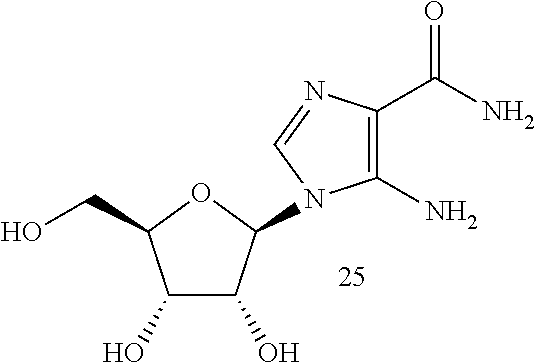Novel ampk agonist compositions and methods of use
a technology of ampk agonist and composition, which is applied in the field of new ampk agonist composition, can solve the problems of articular cartilage breakdown, limited treatment options, and inflammatory conditions (and associated pain) that pose a considerable health burden in humans, and achieve the effects of increasing disease severity, promoting nuclear factor activity, and increasing vcam-1 expression
- Summary
- Abstract
- Description
- Claims
- Application Information
AI Technical Summary
Benefits of technology
Problems solved by technology
Method used
Image
Examples
examples
[0066]The present invention provides novel compositions of matter comprised of AICAR that are adapted for localized delivery and treatment of musculoskeletal diseases and injuries. In the examples below the novel or test composition indicated as NOVEL was comprised of 1.3 mg / ml solutions of AICAR. The purpose of this study was to evaluate the clinical response of racing and non-racing horses with joint and / or soft tissue lameness to various doses of AICAR, either injected intra-articularly or locally infiltrated into the affected soft tissue structure. Clinical cases actively in training for their sport, or racing, demonstrating lameness were selected by various attending veterinarians. Selection criteria for the clinical cases entered into the study were: male or female, any age, with lameness demonstrating heat, effusion, and pain upon flexion and / or palpation. In most cases, multiple joints or soft tissue structures per animal were treated. In some cases, joints and soft tissue s...
case examples
E. Case Examples
[0068]I. Signalment (Sx): Horse No: 1 (Massachusetts, U.S.), 6 year old Standardbred (SB) pacing mare.
[0069]History (Hx): Poor racing performance.
[0070]Clinical Signs (CS): Bilateral effusion at anterior aspect of front coffin joints. 1 / 4 pain to hoof testers; 1 / 4 lameness, swelling, pain.
[0071]Diagnosis (Dx): Synovitis of front coffin joints.
[0072]Treatment (Tx): 2.5 cc NOVEL and 0.5 cc gentamicin / joint (8 / 22 / 12).
[0073]Results (Rx): 7 days post-injection: negative pain, swelling, lameness. Raced and won in 1:56.2. (Previously raced approx. 1:59).
II. Sx: Horse No: 2 (Rome, Italy), 6 year old SB trotting mare.
[0074]Hx: Chronic generalized lameness; poor performance.
[0075]CS: 4 / 5 lame RF localized to fetlock and coffin joints.
[0076]Dx: Radiographs reveal osteoarthritis of RF fetlock. Synovitis of front fetlocks, coffins, and distal hocks.
[0077]Tx: 2.5 cc NOVEL and 0.5 cc amicacin×6 joints: LF and RF fetlocks, LF and RF coffin joints, LTMT and RTMT joints (7 / 30 / 12).
[007...
PUM
| Property | Measurement | Unit |
|---|---|---|
| concentration | aaaaa | aaaaa |
| concentration | aaaaa | aaaaa |
| distance | aaaaa | aaaaa |
Abstract
Description
Claims
Application Information
 Login to View More
Login to View More - R&D
- Intellectual Property
- Life Sciences
- Materials
- Tech Scout
- Unparalleled Data Quality
- Higher Quality Content
- 60% Fewer Hallucinations
Browse by: Latest US Patents, China's latest patents, Technical Efficacy Thesaurus, Application Domain, Technology Topic, Popular Technical Reports.
© 2025 PatSnap. All rights reserved.Legal|Privacy policy|Modern Slavery Act Transparency Statement|Sitemap|About US| Contact US: help@patsnap.com

